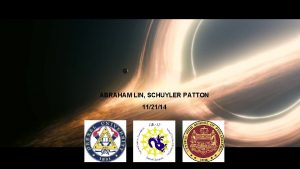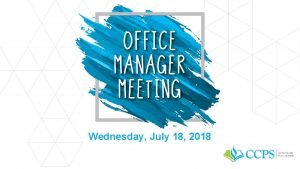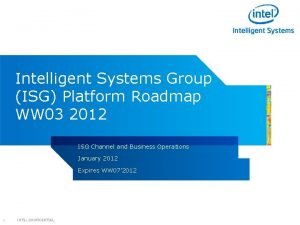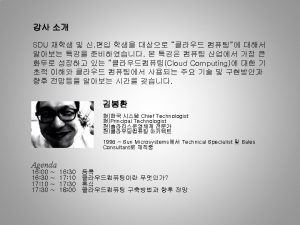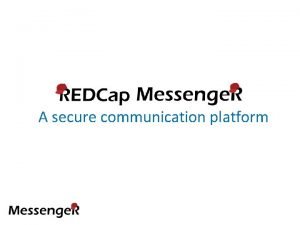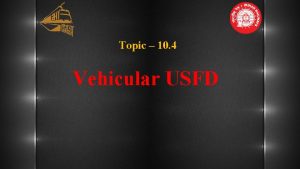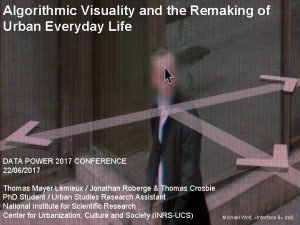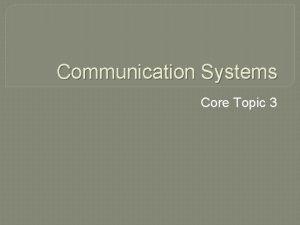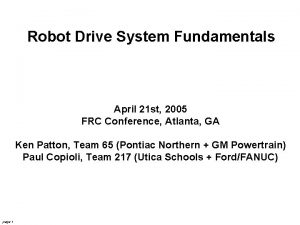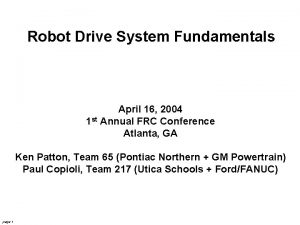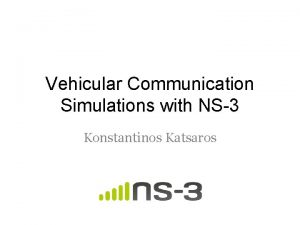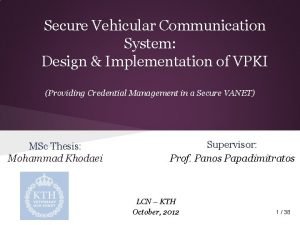Patton Visuality TM Platform Vehicular Communication Systems for

























- Slides: 25

Patton Visuality. TM Platform Vehicular Communication Systems for Situational Awareness Gun Akkor Patton Electronics Co. gakkor@patton. com

2 EMERGENCY SERVICES WORKSHOP Roadmap • • • Situational awareness System architecture Application challenges Performance evaluation Future research Concluding remarks 9/29/2020

3 EMERGENCY SERVICES WORKSHOP What is Situational Awareness? And why do we need it? 9/29/2020

4 EMERGENCY SERVICES WORKSHOP 9/29/2020 Situational awareness • Collect real or near real-time sensory input from mobile and fixed assets: ▫ ▫ Video Audio GPS Other I/O (e. g. on-board car diagnostics, door locks, panic button) • Aggregate at a central location to provide a cognitive reaction to a condition or event.

5 EMERGENCY SERVICES WORKSHOP 9/29/2020 Situational awareness (cont’d) • Make data available to multiple users ▫ Support different platforms: desktops, laptops, handheld computers, PDAs and Smartphones ▫ Allow content sharing between local and remote users • Allow remote configurability of the system to adapt to changing conditions on the field.

6 EMERGENCY SERVICES WORKSHOP 9/29/2020 Applications • Support of law enforcement personnel ▫ In police cruisers replacing existing DVR solutions • Emergency response assistance ▫ In coordination of fire and rescue operations • Protection of personnel, vital equipment and goods ▫ School buses ▫ VIP protection ▫ Guarantee integrity of transferred goods • Transfer of valuable commodities ▫ Protection of armored vehicle fleets

7 EMERGENCY SERVICES WORKSHOP 9/29/2020 Components of Visuality Platform A high-level overview

8 EMERGENCY SERVICES WORKSHOP System Architecture 9/29/2020

9 EMERGENCY SERVICES WORKSHOP 9/29/2020 In-vehicle “remote” units Model T 7714 Model T 7712 • Up to 4 composite (NTSC/PAL) camera inputs • Up to 4 line-level mono audio sources • On-board GPS receiver with standard NMEA-0183 GPGGA and GPVTG output • Video encoded (MPEG 4) up to D 1 (720 x 480) resolution and 30 fps per channel for on-board storage on hard disk or SD/SDHC card • Video encoded (H. 264) up to SIF (352 x 240) resolution and 15 fps per channel for over the air transmission

10 EMERGENCY SERVICES WORKSHOP 9/29/2020 In-vehicle “remote” units (cont’d) Model T 7714 Model T 7712 • Audio sampled at 22. 05 k. Hz, encoded (AAC) at 16 -128 kbps • Metadata and audio multiplexed with video as an MPEG 2 TS • PTZ controller on RS-485 serial interface (supports Pelco-D and Rvision protocols) • Support for multiple cellular network technologies (GPRS, EDGE, 1 x. RTT, EVDO, HSPA) using PCI Express form factor modems • 12 V DC input via standard car or rechargeable lithium ion battery

11 EMERGENCY SERVICES WORKSHOP 9/29/2020 Command “headend” server • Compact PCI computer blade with accompanying 2 U rackmount chassis • Gatekeeper of the entire system • Terminates VPN connections • Aggregates received content and makes it available as multicast streams to local and remove users • Serves KML pages that can be network-linked from Google Earth • Supports asset sharing up to 24 remote units

12 EMERGENCY SERVICES WORKSHOP Command shift concept 9/29/2020

13 EMERGENCY SERVICES WORKSHOP 9/29/2020 Command shift concept (cont’d) • Remotes register with the primary command server (CS) at startup and pull their current assignments. • Secondary command servers also register with the primary and pull the list of remotes that are assigned to them. • Primary CS can move any asset to/from a secondary and make content available to operators of the secondary. • Primary CS can recall any unit when needed.

14 EMERGENCY SERVICES WORKSHOP Design Challenges Trade-offs and design choices 9/29/2020

15 EMERGENCY SERVICES WORKSHOP 9/29/2020 Video compression algorithms • Adaptive frame rate change (3. . 30) • Adaptive bit-rate change (40 Kbps – 2. 5 Mbps) • Adaptive quantization – dynamically adjust QP parameter to target constant bit rate (CBR) • Increased group of picture (GOP) size • Only P-frames, no B-frames are used to eliminate buffering needs at the receiver • Force an I-frame when scene change is above 40%

16 EMERGENCY SERVICES WORKSHOP 9/29/2020 Remove command control • Common Object Request Broker Architecture (CORBA) ▫ Standard defined by Object Management Group (OMG) ▫ Allows multiple machines to communicate over the network over IIOP protocol (Internet Inter-orb Protocol) ▫ Well defined uniform application programming interface (API) ▫ Transparent access whether local or remote

17 EMERGENCY SERVICES WORKSHOP 9/29/2020 Adaptive rate control Measured EV-DO Rev. A Rates Rate (kbit/sec) RSSI (d. Bm) 800 700 600 400 300 200 100 0 -100 -200 1 4 7 10 13 16 19 22 25 28 31 34 37 40 43 46 49 52 55 58 61 64 67 70 73 76 79 82 85 88 91 94 97 100 103 106 109 112 Rate/RSSI 500 Sample Points

18 EMERGENCY SERVICES WORKSHOP 9/29/2020 Adaptive rate-control (cont’d) • Light-weight probe packets sent from remotes to headend to record round trip time (every 2 seconds) • Queue backlog on the cellular network interface is measured (every 2 seconds) • A moving average window is used to smooth measurements (5 to 20 -sample size) • Moving average backlog value is compared to a configurable threshold

19 EMERGENCY SERVICES WORKSHOP 9/29/2020 Adaptive rate-control (cont’d) • Rate is adjusted such that maximum amount of data put on the queue in one RTT time never exceeds the available queue space – a simple delay-bandwidth product alike approach

20 EMERGENCY SERVICES WORKSHOP Prototype setup System evaluation 9/29/2020

21 EMERGENCY SERVICES WORKSHOP 9/29/2020 Experimental Setup • 5 -vehicle fleet • Each equipped with 4 NTSC cameras facing front, rear, left and right side • Cellular-GPS combo antennas places on the roof of each vehicle • Units are configured to transmit all 4 -streams, CIF size (352 x 240) , 10 fps and 100 kbps

22 EMERGENCY SERVICES WORKSHOP 9/29/2020 Experimental results Adjusted rate on the cellular uplink Instantaneous and moving average round-trip-delay (5 sample window)

23 EMERGENCY SERVICES WORKSHOP 9/29/2020 Visuality System in Action A short demonstration video

24 EMERGENCY SERVICES WORKSHOP 9/29/2020 Future directions • Alternative wireless technologies ▫ Wi. Max ▫ LTE • Incorporate vehicle’s on-board diagnostic computer (OBD) ▫ Engine codes ▫ Sudden acceleration/de-acceleration • Connecting tracking devices, PDAs, digital video recorders over 802. 11 or 802. 15

25 EMERGENCY SERVICES WORKSHOP 9/29/2020 Future directions (cont’d) • Improve adaptive rate-control ▫ Smooth out instantaneous rate spikes ▫ Investigate scalable video extensions for rate adaptation • Open-platform software and hardware ▫ Open to integration of other software and hardware modules
 Momentum conservation law
Momentum conservation law Extricacion 1
Extricacion 1 Vehicular cloud
Vehicular cloud Direcin
Direcin Kamela patton
Kamela patton Patton dumpster
Patton dumpster Jade patton
Jade patton Mona lisa agile
Mona lisa agile Schuyler patton
Schuyler patton Kamela patton salary
Kamela patton salary Fasting feasting summary
Fasting feasting summary 233 general patton ave mandeville la
233 general patton ave mandeville la Metropolitan environmental trust
Metropolitan environmental trust Core intelligent systems platform
Core intelligent systems platform Communication platform as a service
Communication platform as a service Secure communication platform
Secure communication platform Fspos vägledning för kontinuitetshantering
Fspos vägledning för kontinuitetshantering Novell typiska drag
Novell typiska drag Tack för att ni lyssnade bild
Tack för att ni lyssnade bild Ekologiskt fotavtryck
Ekologiskt fotavtryck Varför kallas perioden 1918-1939 för mellankrigstiden?
Varför kallas perioden 1918-1939 för mellankrigstiden? En lathund för arbete med kontinuitetshantering
En lathund för arbete med kontinuitetshantering Kassaregister ideell förening
Kassaregister ideell förening Tidbok för yrkesförare
Tidbok för yrkesförare Anatomi organ reproduksi
Anatomi organ reproduksi Förklara densitet för barn
Förklara densitet för barn








